Located on the margins of Kibale forest national park, Bigodi Wetland Sanctuary is a community-based initiative with the main objective of protecting the former Magombe swamp. In the past, the wetland was 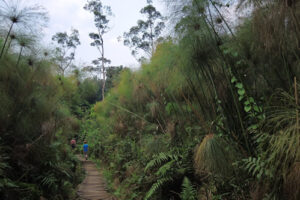 called Magombe swamp. Magombe means “graveyard”. Many people lost their lives during the construction of the bridge at the sanctuary. The name was changed to Bigodi Wetland sanctuary in 1990. “Bigodi” was derived from the Rutooro word “Kugodya” which means to Walk in a tired way.
called Magombe swamp. Magombe means “graveyard”. Many people lost their lives during the construction of the bridge at the sanctuary. The name was changed to Bigodi Wetland sanctuary in 1990. “Bigodi” was derived from the Rutooro word “Kugodya” which means to Walk in a tired way.
In the past, the local people found it hard and tiring to pass through the wet swamp to reach Kibale forest hence coming with the name “Bigodi”. The Bigodi wetlands sanctuary covers a total surface area of 4km2, off the road between Kamwenge and Fort Portal in western Uganda.
Bigodi wetland sanctuary is rich with vegetation and wildlife species. Eight different primate species have been recorded in the wetland namely; red colobus monkeys, black and white colobus, chimpanzees, red-tailed monkeys, grey-cheeked mangabeys, blue monkeys, olive baboons and vervet monkeys. Unique birds like the great blue turaco, the crested crane and purple breasted sunbirds are also present. Other animals that live in the environs of Bigodi are wild pigs, antelopes, otters and Mongooses.
Facts About the Bigodi Wetland Sanctuary
- The distance between Kampala and Bigodi is about 244km and only takes six hours by road travel.
- The great blue Turaco is the most sought after bird species in the Swamp in spite of the sanctuary being home to over 100 species of birds.
- An experienced and knowledgeable bird guide is recommended for a birding expedition at the wetland.
- Visitors to Bigodi use the same safari lodges as those of Kibale forest national park since they are next to each other. The Recommended accommodation facilities include Turaco Tree Tops, Primates Lodge, Ndali Lodge, Chimpundu Lodge, Kyaninga Lodge, Crater Lodge, Chimpanzee forest guest house, Chimps Nest and Kibale Forest Camp. These lodges are categorized as budget, mid-range or Luxury.
- Bigodi wetland sanctuary is regarded as a benchmark of sustainable tourism and development (how natural resources are managed by the community to benefit all stakeholders).
Bigodi Swamp and the work of Kibale Association for Rural and Environmental Development (KAFRED)
Established in 1992, Kibale Association for Rural and Environmental Development (KAFRED) is a community-based organization responsible for the management of Bigodi Wetland sanctuary. The organization was set up to uplift the lives of the people while also protecting the natural environment. It has grown a lot ever since it was established and now has over two hundred members from and initial four. All people living around the wetland are automatic non-voting members of the organization but to 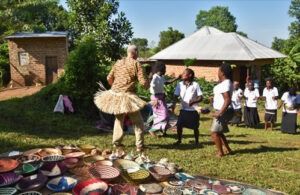 become a full member, one must pay a certain fee. The operations of the organization are run by a committee of 9 members who are voted every after two years at one of the annual sittings. Gender balance is taken seriously during the elections.
become a full member, one must pay a certain fee. The operations of the organization are run by a committee of 9 members who are voted every after two years at one of the annual sittings. Gender balance is taken seriously during the elections.
The project has visible achievements and many people’s lives have been impacted. For instance, KAFRED has tried to mobilize the local communities to benefit from tourists who visit the Bigodi swamp. In fact, some of the revenue got from tourism has been invested in building schools and other learning facilities to improve quality and access to education for the local 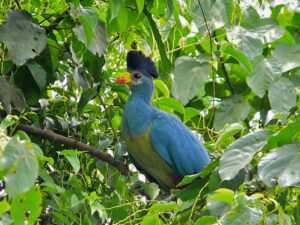 community. The organization runs scholarship programs and contributes towards teacher salaries. Soft loans have been extended to families to set up businesses or pay school fees. Access to water and energy has been made easy by building boreholes and supplying fuel-saving stoves respectively. KAFRED has also built accommodation for medical staff in the community health centers.
community. The organization runs scholarship programs and contributes towards teacher salaries. Soft loans have been extended to families to set up businesses or pay school fees. Access to water and energy has been made easy by building boreholes and supplying fuel-saving stoves respectively. KAFRED has also built accommodation for medical staff in the community health centers.
Vulnerable people like women, girls and the disabled have been empowered by teaching them how to make handcrafts to self-sustain 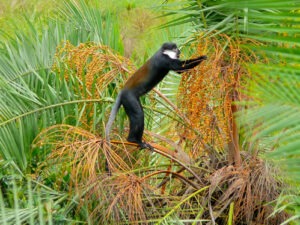 themselves. The organization has also encouraged its members to get involved in tourism by advising them to turn their homesteads into experiential spots of African life setting for international tourists.
themselves. The organization has also encouraged its members to get involved in tourism by advising them to turn their homesteads into experiential spots of African life setting for international tourists.
Though KAFRED has registered huge success in the community, it is facing some challenges. Human settlement in the wetlands due to population expulsion is the number one challenge of the project. People are putting pressure on the fragile swamp through cultivation and expansion of their homesteads. Human and wildlife 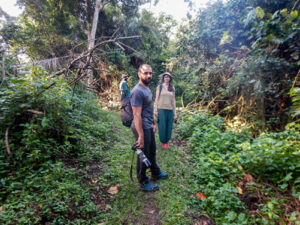 conflicts are still in existence due to the intrusion of animals in the farmlands of the people. Although Poaching has been marginalized, incidents of killing animals like sitatunga for meat still occur.
conflicts are still in existence due to the intrusion of animals in the farmlands of the people. Although Poaching has been marginalized, incidents of killing animals like sitatunga for meat still occur.
How is KAFRED trying to solve some of the challenges? KAFRED is helping eliminate poaching by recruiting former poachers as Tour Guides. They are lobbying for employment opportunities for the locals from other enterprises other than relying on tourism only. KAFRED carries out seminars and workshops to sensitize the people about the importance of the wetlands to them and the environment.
Things to do in Bigodi Wetlands Sanctuary
Bigodi wetland sanctuary tours open up opportunities for encountering various primate and bird species. Most Tourists visit the sanctuary later in the afternoon and after chimpanzee trekking in Kibale forest. The tour of the Bigodi Wetlands Sanctuary takes about 3 hours walking on raised wooden pathways. 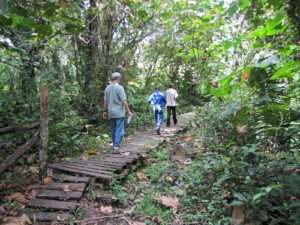 These pathways allow one to observe rare bird species and 11 different types of monkeys. The tour ends in one of the local villages. This village tour involves visiting different social facilities and homesteads to show support for their efforts in conserving and preserving the swamp. We can look more closely at the main activities at the Swamp as follows: –
These pathways allow one to observe rare bird species and 11 different types of monkeys. The tour ends in one of the local villages. This village tour involves visiting different social facilities and homesteads to show support for their efforts in conserving and preserving the swamp. We can look more closely at the main activities at the Swamp as follows: –
Guided Nature Walks: The nature treks have two sessions – Morning and afternoon. The morning session starts at 7:30am and the afternoon one at 3pm. It costs 30 US Dollars per person to do a nature walk around the swamp. A well experienced and knowledgeable local guide leads the trek around the swamp. The Guide will ensure that the activity is 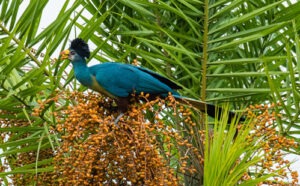 insightful and exciting. The Guide will also ensure that you encounter most of the interesting wildlife species in the wetland.
insightful and exciting. The Guide will also ensure that you encounter most of the interesting wildlife species in the wetland.
Birding: The Bigodi Swamp is one of the best birding spots in Uganda. It is home to some of the rarest birds in the world. They include the great blue turaco, purple breasted sunbird, papyrus gonolek, Abyssinia, green breasted pitta and crested crane. Birds love the swamp area because of the availability of water, green vegetation and absence of many predators.
Village Walk: The villages around the swamp are an excellent representation of rural life in Uganda and many developing countries in Africa. Visitors can see green farmlands, mud/ brick homes, joyful children playing, domestic animals grazing in the green fields, women going about their business in their 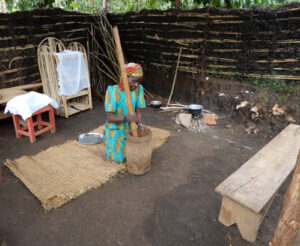 open homes and men enjoying that strong drink at the trading centers. Tourists can engage in activities like cooking or tasting the local foods. They can also learn how to grow tea/coffee in the farmlands and visit the community-based facilities (schools, orphanages and health centers). A visit to the Bigodi Women group is one of the highlights of visiting the Bigodi Sanctuary. At the Centre, girls and women engage in making African attires. These include designing bangles, shoes, necklaces, earrings and many more. Buying from these hardworking and creative women is considered a noble gesture. Some of their products are imported to other countries. In addition to the social projects, there are other exciting things to do within the sanctuary like learning how to make local beer, visiting the local herbalist or one of the village elderly for storytelling. The Elders have seen the different changes at the sanctuary and can tell you what was and is.
open homes and men enjoying that strong drink at the trading centers. Tourists can engage in activities like cooking or tasting the local foods. They can also learn how to grow tea/coffee in the farmlands and visit the community-based facilities (schools, orphanages and health centers). A visit to the Bigodi Women group is one of the highlights of visiting the Bigodi Sanctuary. At the Centre, girls and women engage in making African attires. These include designing bangles, shoes, necklaces, earrings and many more. Buying from these hardworking and creative women is considered a noble gesture. Some of their products are imported to other countries. In addition to the social projects, there are other exciting things to do within the sanctuary like learning how to make local beer, visiting the local herbalist or one of the village elderly for storytelling. The Elders have seen the different changes at the sanctuary and can tell you what was and is.
The Snake Park: This is an upcoming tourism product under the KAFRED project. The wetland is a breeding spot for a number of reptile species. It can be challenging to see the snakes unless you spend more time at the wetland. KAFRED is developing a safe and better avenue of sighting the snakes by visitors of Bigodi Wetlands Swamp. This is an additional experience to the popular nature walk taking place in the area


